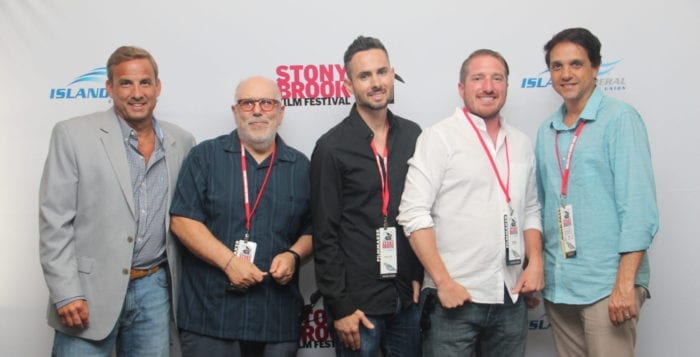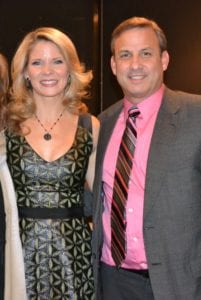One on One with ALAN INKLES

By Rita J. Egan
When Alan Inkles, director of the Staller Center for the Arts, moved from Brooklyn to Port Jefferson Station at the age of 11, the stage was being set for him to one day play an integral part in creating an impressive cultural and arts community right here on Long Island.
After graduating from Comsewogue High School, he headed out to Los Angeles to play soccer and study acting. After discovering he wasn’t cut out for college sports, he seized the opportunity to concentrate on the craft of acting and honed his talents working on commercials and pilots. Fortunately, for Long Islanders, he soon returned to New York and enrolled at Stony Brook University, earning his bachelor’s and master’s degrees in theater arts.
The founder of the Stony Brook Film Festival, his loyalty to the university has paid off for local residents who can attend high-quality shows just minutes away from their own homes. His success is a combination of meeting the needs of performers, being open to the opinions of audience members and appreciating his hard-working team, generous sponsors and the university’s supportive administration.
Recently, while nursing the flu and screening movies for the upcoming annual film festival, the director, who has brought the likes of Ray Charles, Harry Belafonte, Patti LuPone and more to the center, took time to answer a few questions about his stellar career.

How long have you been the director of the Staller Center, and how did you get the job there?
I injured my knee while performing in 1983, and I had just graduated from Stony Brook and had worked as a student for the Fine Arts Center [the original name of Staller Center] during my years. And, as I couldn’t perform with my injury for a while, I asked the director of the center, Terry Netter, if he could use a theater manager — which I had done as a student. He hired me and at least seven titles later and an International Theatre Festival that I created — what really kept me interested in the early years — and beginning to do all the programming in 1992, I took over as director upon Terry’s retirement in 1995. So, I guess officially I’ve been the director for 21 years.
You have a long history with Stony Brook University. What do you love about it?
What don’t I love about Stony Brook University? I did my undergraduate and graduate studies here. Two of my three kids and my son-in-law graduated from here, and I’ve been here as an employee and student for almost 37 years. I’ve enjoyed working for three presidents and almost a dozen provosts — permanent and acting ones, have made numerous friends with faculty, staff over the years, and have the greatest staff anyone could dream of having — some of which have been with me for my entire time as director. I love the energy of the students, the challenges that a public university continues to throw my way and the amazing ambiance of a continually growing and improving university. Stony Brook is about its amazing people, and I’ve been fortunate to be a member of this great collegial community for so long.
You’ve been credited with making the center what it is today. How did you go about that?
I guess longevity allows that to work. My predecessor Terry Netter opened the Staller Center back in 1976, 1977. It was a different time. You know back in those days the center was really more for the university, supporting the music department, the theater department, which we still do, and they did a couple of ballets and orchestras.
Early on when I started getting the itch, Terry asked to me to start programming. It was growing pains because I wanted to do more jazz and pop and children’s programs, because that’s what I saw we needed to do, because it was a different era. The arts centers of the 1960s and ’70s doing orchestras and ballets were great, and we continued to do them, but we needed to diversify. We needed to get broader. So, he really gave me a lot of leeway to go out and try to find these programs, and I liked the challenge.
What does it take to coordinate all the events the Staller Center presents during a year?
A great team. I can go to a conference, and I come back, and yesterday while being home laying in a bed (recovering from the flu), call my team up and say we’re booking Peter Cincotti. And, within 24 hours, we got a press release, the website, an email, the machine ready on social media, my production team going through the rider knowing exactly what we need so that I was able to approve it because there’s certain needs we have to get for the show. All this happens in 24 hours. I’m not so sure Live Nation could even pull it off in 24 hours!
So it starts with a great team, the confidence that I have the support of my provost (we have a new one this year, Michael Bernstein, who is really great) and a president who basically said to me, the third one I have worked for, “You raise the money, you bring in the audience, you got carte blanche.”
In addition to the performances at the center, you also coordinate the Stony Brook Film Festival. What does preparing for that entail?
Fortunately, over the years my contract administrator, my associate, Kent Marks, has taken on a good chunk of that. He’s great, and my staff have also helped pre-screen a lot of the movies. In the early days, I admit I watched everything. In the first 15, 16 years of the festival I was watching all 400 to 600 films coming in and picking 40. In the last five years we have had over 3,000 films coming in each year.
What have been your favorite personal accomplishments since being director of the center?
That’s an interesting question as I don’t think I’ve really given much thought to personal accomplishments. I’ve really always tried to focus on bringing quality programs in the arts to our faculty, staff, students and community over the years and always have tried to secure excellence and try to both entertain and enlighten our audiences and occasionally challenge them. Personally, I felt a great accomplishment in pulling off a 10-year run of a major International Theatre Festival early on in my career, and when I think back to my first trip to Sundance in 1999, and thinking about how little I knew about film festivals, I certainly am very proud of the fact that we have created a significant and lasting annual festival that grows every year in importance, quality and attendance. I’ve watched dozens of branded festivals in recent years dissolve as we gain strength.
I would also be remiss if I didn’t beam about the Outreach & Education program my staff and I have built. With just an idea over a decade ago to significantly reach out to communities and young people on Long Island, we now provide hundreds of programs at Staller and in our communities and serve several thousands of individuals who may not have had the opportunity to partake in the arts with workshops, school/library performances and complimentary Staller tickets. This is, of course, important for the future of the arts, and I am very proud of this growing and important part of our operation.
What are your plans for the Staller Center’s future?
I spent a great deal of time last weekend at the annual arts center/producer/ talent booking conference discussing with agents and artists and colleagues that we need to be creative, daring and also listen to our audience going forward. This digital era provides so much entertainment for people where they never need to leave their homes or their phones. We have to find ways through unique, different and exciting programs in the arts — theater, music, art and film — to take people away from their own arts centers —their 70-inch screen TVs.
It means continuing to be relevant so that corporate and private individuals will support us so we can bring these exciting programs to our campus and community, continue to keep the prices reasonable and make them available to all. I can promise you, I will continue to search far and wide for these live programs and films and continue to ask before I book something, “Is this something my audience needs to see?” That line has replaced the line that used to be, “What do they want to see?” And, when I stop asking that question and feel I can’t lift that proverbial rock any higher to find that program, I’ll know it’s time to pass on the baton. Fortunately, I don’t see that time coming too soon, and I’m also so grateful that my staff seems to want to keep me around a bit longer as well!






